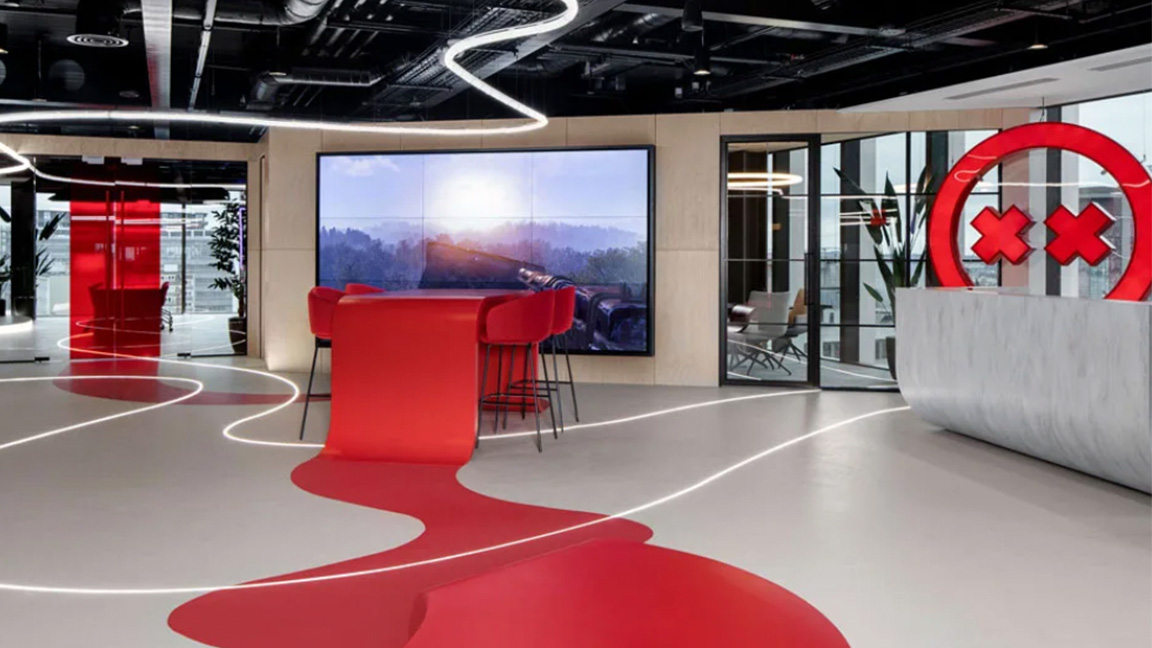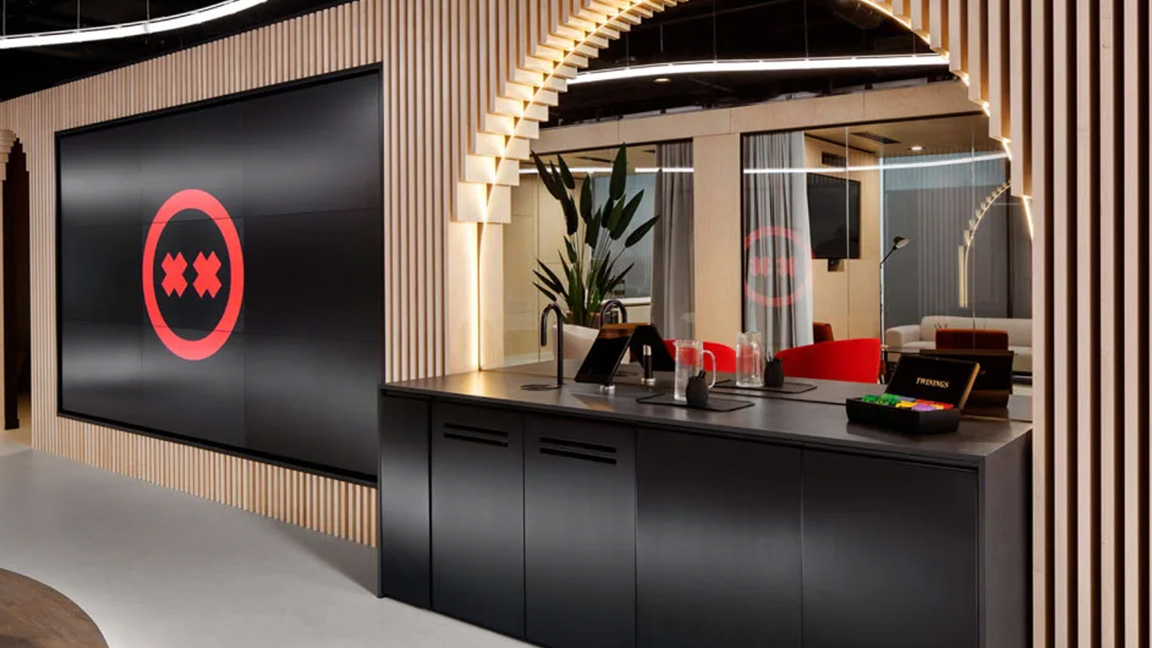Facepunch Studios Makes a Statement
Game developer wows visitors with stylish offices and sophisticated AV.

When you’re a respected independent game developer like the U.K.’s Facepunch Studios—known for the popular Steam games Garry’s Mod, Rust, and Chippy—you want to make a statement with your physical facilities.
This is precisely what Facepunch has done with its new offices in Birmingham’s upscale Colmore Row neighborhood. Designed by Oktra’s Emily Benussi, Facepunch’s new offices are a mix of high-tech AV to dazzle clients while enabling BYOD videoconferencing, eye-catching decor, and furniture that appear to flow into the floor like paint. There are also employee-pleasing amenities including a gaming room (with the company’s games available to play), curved breakfast bar with stools, and dedicated "wellbeing corner" where they can disconnect from their jobs.
The overall setting is so stunning that Facepunch Studios and Oktra recently won the ‘Project of the Year: Workplace Interiors 5,000 to 15,000 Square Foot” category at the Mixology North Awards 2023.
The AV equipment integration/installation for Facepunch’s new offices was performed by Vision On AV Systems using equipment from Kramer and other sources. The project was on a tight schedule: “We started talking about it in October 2022,” said Cliff Bird, a director with Vision on AV. “It had to be finished by March 2023, although we had to wait until April 2023 to fully commission it."
Networking Is Key
Central IP networking is key to the success of this facility. Facepunch wanted an in-house AV system capable of providing BYOD videoconferencing and collaboration to its staff—including easy and reliable wireless presentation capabilities—across all of its office spaces. To make this happen, Vision On AV deployed a segregated, highly stable AV-over-IP network to provide consistent wireless access everywhere. Ubiquiti Enterprise Layer 3 switches were used as the foundation of this network, which was carefully laid out to ensure minimal service disruptions and fast commissioning.
A daily selection of the top stories for AV integrators, resellers and consultants. Sign up below.
In terms of actual segregation, Facepunch’s AV system is split into four distinct control systems: one for each of the two video walls, plus one for the boardroom and one for office audio/remote control stations. Each system is controllable in a Central Communications Room (CCR), which is the heart of the AV installation. Kramer’s KC-BRAINware software platform controls all four systems, including sources, encoders, and multi-zone audio amplifiers/mixers. They are all connected to the CCR using Ubiquiti Enterprise network switches with fiber links.
Since time was an issue on this project, Vision On AV came up with a quick way to commission this facility one space at a time. The company used a simple router and a single Kramer SL-240C, a compact 16-port master/room controller with PoE to test the AVoIP pathways. Once the AV connections were commissioned, Vision On AV connected everything to the CCR’s KC−BRAINware platform.

The task of wowing visitors to the Facepunch lobby is assigned to the two video walls. Each wall is comprised of nine 55-inch NEC flat panel monitors in a 3x3 configuration. The feeds to these monitors are delivered from the CCR using AVoIP rather than a conventional video control unit. "AV-over-IP is just so much more flexible and easier to use to populate these screens,” said Bird.
Each of the NEC monitors within the video walls are connected to its own Kramer KDS-DEC7 decoder and Cloud DCM1 digitally controlled zone mixer. “This one-to-one setup provides a very versatile way to use the media walls,” explained Matthew Hale, pre-sales and technical support engineer for Kramer UK. “They can either have it set as a video wall, with one image on the entire thing. They can also use the screens individually should they want to. That’s another reason we chose AV-over-IP: scalability. The client can use up to nine sources on one media wall and have individual screens showing different things, without any major changes to their infrastructure at all.” The media walls can even be reprogrammed remotely from the lobby.
Minimal Space, Maximum Sophistication
Visually, Facepunch’s 10-seat boardroom is a very minimalist space, but the simplicity belies its AV sophistication. The boardroom is a fully automated space with wireless presentation and multi-platform videoconferencing, interactive displays, and zoned audio.
The boardroom uses an 86-inch 4K LG UL series monitor and Poly Studio X70 videobar as the basis of its videoconferencing system. The X70 comes with dual 4K lenses; two-way stereo speakers, aluminum cone tweeters, and advanced bass ports; Poly DirectorAI smart camera technology; and NoiseBlockAI noise reduction technology. The system also includes a Kramer KDS-DEC7 AVoIP decoder and PA-120Z power amplifier. Inputs to the display, control of the X70, and selection of sources are all managed using a Kramer KT-107 touchpanel, which also manages the room lighting and blinds.
“Primarily what Facepunch wanted was a programmed touchpanel system so that they could start the room and put it in the mode that they want to use easily, along with a very user-friendly way of controlling the components in the room,” Hale explained. “The control system is all Kramer: their touchpanels, their control processor, and the other items that they have in that room.
"AV-over-IP is just so much more flexible and easier to use to populate these screens.”
Cliff Bird, Vision on AV
"One device that stands out is the Kramer VIA Campus2, which is a wireless collaboration device. Any user can connect to it wirelessly and use all of the peripherals that are connected physically to that device. Now this is a common way of doing things these days, but Kramer was one of the first to the market with that capability of sharing USB devices wirelessly.”
Five other rooms, including some executive offices and smaller meeting rooms, have been equipped with videoconferencing and BYOD capabilities. "They’re using Logitech cameras controlled by Kramer VIA Versa virtual camera drivers, and Kramer VIA Connect2 wireless presentation, collaboration, and conferencing solutions, so that you've got wireless BYOD capability within each of the rooms," said Bird. To support AVoIP video delivery on a range of video monitors, Kramer KDS-DE7 decoders were added to the boardroom, game development area, breakfast bar, meeting rooms, and other interactive spaces.
[SCN Installation Showcase 2023]
Meeting Facepunch’s tight installation schedule was a big challenge for Vision On AV and Kramer, but it wasn’t the only one. “The biggest challenge for me was supporting the KDS-7 encoders/decoders because these were very new to the market when Facepunch started to have them installed,” Hale said. “That was a learning process for us, for them, and for the integrator as well on how to set this solution up and then how to use it.”
James Careless is an award-winning freelance journalist with extensive experience in audio-visual equipment, AV system design, and AV integration. His credits include numerous articles for Systems Contractor News, AV Technology, Radio World, and TV Tech, among others. Careless comes from a broadcasting background, with credits at CBC Radio, NPR, and NBC News. He currently co-produces/co-hosts the CDR Radio podcast, which covers the Canadian defense industry. Careless is a two-time winner of the PBI Media Award for Excellence.

